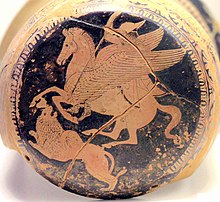Epinetron
This article needs additional citations for verification. (February 2011) |

The epinetron (Greek: ἐπίνητρον, pl.: epinetra, ἐπίνητρα; "distaff"); Beazley also called them onoi, sg.: onos) was a shape of Attic pottery worn on the thighs of women during the preparation of wool, not unlike a thimble for the thigh.[1] Decorated epinetra were placed on the graves of unmarried girls, or dedicated at temples of female deities.[citation needed]
Because of the strong association between wool-working and the Ancient Greek ideal of women and wives—as in the case of Penelope weaving in the Odyssey—it is a shape associated with the wedding.[2]
The theme of its decoration tended to be related to its use. The top surface was often incised to make it rough in order to rub the wool fibers. There was often a female head placed at the closed end, where the knee was covered. Epinetra were often decorated, sometimes depicting black figure Amazon women, as in the case of an epinetron painted by the Sappho painter between 500 and 490 BCE.[3]
References[edit]
- ^ "Epinetron". www.beazley.ox.ac.uk. Archived from the original on 2020-02-17. Retrieved 2020-07-07.
- ^ Compare the loutrophoros, which also had a strong connection to the wedding.
- ^ "Epinetron". World History Encyclopedia. Retrieved 2020-07-07.
External links[edit]
![]() Media related to Epinetra at Wikimedia Commons
Media related to Epinetra at Wikimedia Commons
